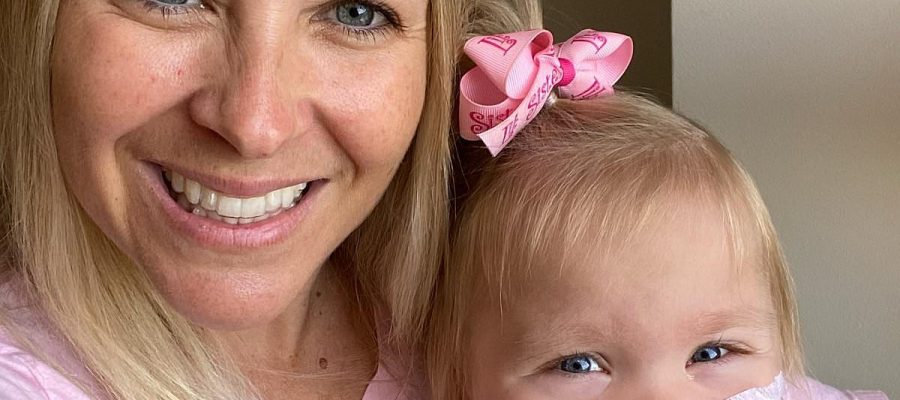Miracle baby girl born with no kidneys and less than one percent chance of survival now thriving after mom donated her own organ
- Emmie Mahoney is now two years old, which doctors thought was ‘impossible’
- Her mother, Andi Mahoney, was able to donate one of her kidneys to Emmie
- READ MORE: Baby born weighing just 1 POUND home after 181 days in hospital
A miracle baby girl born without kidneys has defied the odds.
Emmie Hope Mahoney was born in March 2021 without the vital organ and her mother, Andi Mahoney, was told her daughter would never survive.
However, after donating one of her own kidneys shortly after birth, Ms Mahoney now has a thriving and healthy two-year-old girl.
Ms Mahoney, from Jacksonville, Florida, had a normal pregnancy until her 20-week scan in November 2020 showed her baby had bilateral renal agenesis, a condition in which the kidneys never develop.
The condition occurs in one of about 4,500 live births in the US. More than 40 percent of babies with the condition will be stillborn, and if born alive, most will only live for a handful of hours.

Emmie Hope Mahoney was born in March 2021 without the vital organs and her mother, Andi Mahoney, was told her daughter would never survived

When the time came to give birth, doctors were on standby to give baby Emmie oxygen. She had to be rushed straight into surgery
But Ms Mahoney was determined her daughter would make it.
Shortly after her scan, Ms Mahoney searched for a specialist and found Dr Rueben Quintero, with the Fetal Institute in Miami and made the six-hour drive from Jacksonville to Miami.
He said: ‘Only about 0.013 percent of cases in America [are diagnosed each year]. The reason it’s impossible to survive the condition is because the baby has no fluid. Since they have no kidney to pee, they are not swallowing any fluids like they are supposed to.’
Doctors do not know what causes the condition, but a quarter of cases have a genetic component.
Bilateral renal agenesis, also known as Potter syndrome, also stops the baby’s lungs from developing, so Ms Mahoney had to get infusions of fluids for the baby for 10 weeks while she was still pregnant.
Ms Mahoney told USA Today: ‘I kept traveling to Miami to get more, to keep Emmie alive. My baby needed fluid to breathe. By the time I got to the 34-week mark, I had an [membrane] rupture.’
‘We can’t treat you unless you’re having a heart attack’

An Oklahoma woman with a deadly pregnancy complication claims she was told she could not be treated until her condition was critical due to the state’s abortion ban.
A ruptured membrane is the breaking of the amniotic sac before labor begins and once the sac breaks, there is an increased risk of infection.
The mother-to-be found a Stanford, California hospital that had previously dealt with births of babies with bilateral renal agenesis.
Ms Mahoney said: ‘I hopped on a flight from Jacksonville to California with my membranes ruptured.
‘I wanted to go somewhere that would deliver me my Emmie. Also, they gave me hope that she would live.’
When the time came to give birth, doctors were on standby to give baby Emmie oxygen and rush her straight into surgery.
Ms Mahoney said: ‘I didn’t get to meet her until after she had surgery. I did not know if she could survive after the first day. It was a lot of waiting and praying.’
Emmie’s lungs were underdeveloped and she desperately needed a kidney.
Though people are born with two kidneys, they can live a perfectly healthy life with just one.
The organs are needed to filter waste out the body and regulate the balance of fluids.
Ms Mahoney was able to donate a kidney to her daughter and on July 25, 2023, doctors performed the transplant.
She said: ‘I received the best news of my life when I found out we had matching blood types and that I was approved for the surgery.
‘I didn’t think twice. I knew I was giving my kidney to Emmie.’
Emmie wasn’t able to leave the hospital until she was six months old, and even then, she had to go back to the hospital in California to stay on dialysis – a treatment that helps the body remove extra fluid and waste products from the blood.
This allowed her to survive until she received the transplant from her mother.
Her family then relocated to Atlanta, Georgia, to be close to Children’s Healthcare of Atlanta, which meant she could do two years of outpatient dialysis at home.
She remained on dialysis until she was two and a half years old when she was deemed healthy enough to end the treatment.
Source: Read Full Article
